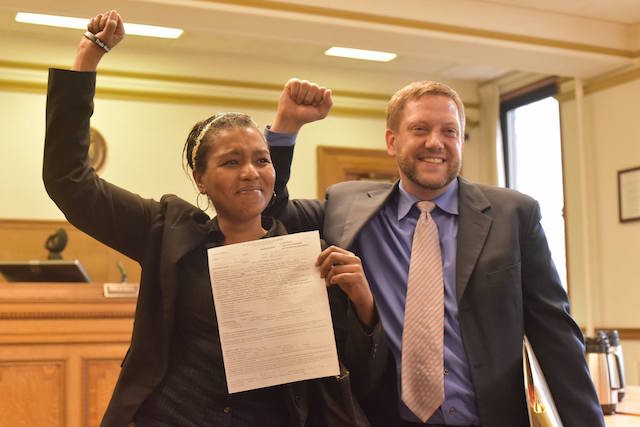 Story by Pete Shaw
Story by Pete Shaw
A small grin crept across Teressa Raiford’s face as the jury acquitted her of second degree disorderly conduct on Thursday April 21. It slowly got a little bigger, and she clapped her hands a couple of times. She certainly was relieved, but perhaps not ecstatic. While walking around downtown a few hours earlier, Raiford expressed confidence that her six peers would find her not guilty. At the same time, she fretted about the repercussions of such a verdict, leaving me with the impression that she would almost consider it a shame if she and her attorney, Matthew McHenry, walked out of court with no reason to file an appeal.
After all, she told me, the trial had given the Black Lives Matter movement over three days of free organizing and education, and it would be a shame not to continue using the court system as a forum. “This is part of the protest,” Raiford said. “It’s a continuity of all the work we’ve been doing.”
That work has been focused on making people aware of, and organizing against, police violence–most clearly in Raiford’s work with Don’t Shoot PDX, a group associated with the Black Lives Matter movement that she helped found after Michael Brown’s murder at the hands of Ferguson, Missouri police officer Darren Wilson on August 9, 2014. It was Raiford’s high profile that led police to target and arrest her at a community art project she helped organize on the one-year anniversary of that murder. The point of that day, Raiford said during cross-examination by Multnomah County Deputy District Attorney Jeffrey Lowe, was to take a break from the many actions initiated to lament the horrific results of police violence, particularly upon people of color, and instead celebrate the lives of people–both dead and alive–who have been affected by that bloodshed.
Some musicians who were supposed to show up to the event couldn’t make it, and so Raiford decided it would be a good idea to put together a panel to discuss police violence. When the panel ended, people decided to move the celebration outside, and then the group–which numbered about 100–took to the nearby intersection at SE 82nd and Division. In memory of the four and a half hours that Michael Brown’s body lay in the street after Wilson murdered him, they settled on occupying the intersection for four and a half minutes. (According to video, the activists ended up closing it off for about seven minutes, holding up traffic for that time.)
A few police arrived and nothing eventful happened. Soon, people returned to the sidewalk to chant and educate; to give passersby something to think about. Quite a few more police arrived with witnesses for the defense estimating that about 13 patrol cars amassed across the street from them. The police did nothing for a short while, and then a few officers came over to get people on the sidewalk. Then a clutch of them walked up to Raiford and seized her. Arresting officers filed reports saying Raiford resisted arrest–struggling, kicking, yelling, and inciting the crowd toward violence. Witnesses who saw the arrest said Raiford was targeted. They also said she offered no resistance and was not screaming at the police.
The original charge against Raiford was that she had been intentionally obstructing traffic when she stood in a right turn lane during the rally, following the occupation of the intersection. But during a pretrial hearing on Monday April 18, Portland police officer Susan Billard gave testimony about Raiford’s arrest that was contradicted by video of the rally. Billard said that Raiford’s presence in the lane forced traffic to a “complete stop” for “5 to 10 minutes,” with motorists eventually having to go around Raiford in order to get past. Judge Michael A. Greenlick, after comparing Billard’s testimony with the video, effectively called Billard a liar and ruled that there was no probable cause for Raiford’s arrest. However, he also ruled that the State could amend its charge and apply it to the stoppage of traffic at the intersection.
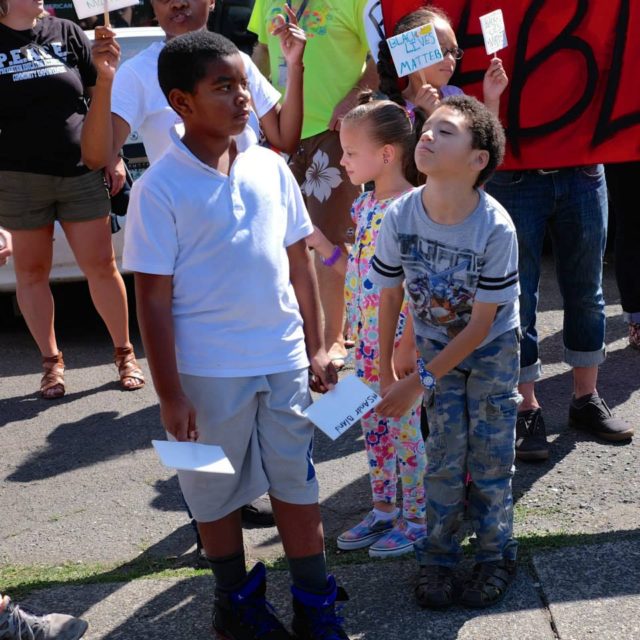
Photo by Kathryn Kendall
In order to find Raiford guilty of second degree disorderly conduct, the jury would have to be convinced that she had “intentionally created public inconvenience or annoyance by intentionally obstructing vehicular traffic on a public lane.” That would require showing that Raiford was the leader of the event who willfully dragged the crowd into the intersection with the explicit intent of stopping traffic.
McHenry brought forth at least 10 witnesses who had attended the event on August 9, 2015. Upon questioning, each of them described the taking of the intersection more as an organic act on their and the other attendees part whose intention was not to stop traffic, but to make people aware of police violence and the destruction it brings to people and communities of color, as well as to impoverished people. As well, most of them, if not all, noted that other people were also in the street when Raiford was arrested, either implying or directly stating that they believed Raiford was targeted by the police. Furthermore, those witnesses said that they would have gone into the intersection even if there was no traffic.
At one point Judge Greenlick made a comment to McHenry about his accumulation of similar responses from the defense’s witnesses, implying that this may have been excessive. McHenry looked up and replied, “Yes.” It was an excellent strategy. When cross-examining those witnesses, prosecuting attorney McMahon (who had been joined by Lowe after the missteps of the pre-trial proceedings) tried to evince replies that would convince jurors that Raiford had engineered the takeover of the intersection, explicitly intending to shut down traffic. That was no mean task as McMahon was basically forced into questioning the witnesses in a manner implying that each one really had no idea what she was talking about. That might work with one or two witnesses, but by the time you reach seven or eight, it becomes a very thin gruel.
Another problem for Lowe and McMahon was that they never managed to control the narrative. Simply, they had very little to work with. The video that proved to be the primary evidence which decided the jury in Raiford’s favor was shot by Laura Vanderlin, a witness for the defense. Too, the prosecution never seemed entirely sure just of what it was seeking to convict Raiford. Her crime, the jury was often told, had nothing to do with her police interaction, but with her leading people to the intersection with the explicit intention of bottling up traffic. Yet nearly every time McMahon cross-examined the witnesses for the defense, he was asking them questions relating to Raiford’s arrest.
The highlight of the trial came when Raiford took the stand. She introduced herself to the jury through her story of growing up a foster child in Portland, but one who grew up with a strong sense of community. She left for Dallas, Texas in 1996. While visiting in 2010, her nephew was gunned down outside a Portland nightclub. That murder is what pushed her into her activism. She has appeared before a congressional committee and had an audience with First Lady Michelle Obama. From many angles, she was clearly as a very serious person heavily invested in working on the problem of police violence.
In response to questions from McHenry, Raiford talked more deeply about her activism work and its relation to the events of August 9, 2015. “The biggest problem we have in America,” she said, “is that people in poverty are policed differently.” Raiford said that on that day–one year after Michael Brown’s murder–people went into the intersection at SE 82nd and Division, not with the intent to stop traffic, but to display the work that children had created as part of the community art project she had organized. Her role was to make sure people remained safe–working “safety patrol” as she called it.
The more experienced Lowe cross-examined Raiford, beginning by saying that he understood why Raiford would be upset over being arrested. “I’m not upset that I was arrested,” said Raiford, who took control over the narrative from the start, noting that it gave her the opportunity to show the integrity of the Black Lives Matter movement. When Lowe amended his statement to say she must have been upset about being put in a patrol car, Raiford responded again that it did not upset her because it helped educate people about how police act.
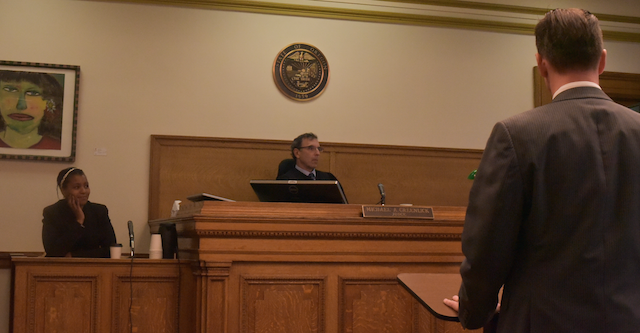
Photo by Joe Meyer
In fact, it was Lowe who seemed upset. When he asked Raiford about why she got arrested–for which she was not on trial–Raiford said she didn’t know and agreed with Lowe that it is not okay to break laws. Lowe then asked, “How else would you get arrested if you didn’t do wrong?” Raiford sedately rejoindered by asking Lowe if it was not in fact his job to discern that during the trial. This prompted Lowe to slightly raise his voice, telling Raiford for the first of three times, “I get to ask the questions here.” At another point when getting nowhere with his questioning, Lowe put a hand behind his back, clenching it into a fist so taut that it began quivering.
Raiford never budged an inch. When Lowe said he wanted to ask her some questions about the significance of the numerous signs such as those reading “Black Lives Matter” that appeared in the video, but did not want to show the video to the jury, which had already seen it numerous times, Raiford replied, “You can play the video so I can see each one (of the signs). I don’t mind.” She knew full well that another viewing of the video could only help her case.
When during the viewing Lowe noted a stopped bus with passengers on it and asked Raiford, “You wouldn’t describe that as trapped, held hostage?” she responded, “You’ll have to ask the bus driver.” When asked if it was true that the traffic was stopped for seven minutes, she replied, “I have no idea. I wasn’t the timekeeper,” reiterating that she was “safety patrol”, along with several others to make sure people stayed out of harm’s way, buttressing the statement made by most of the other defense’s witnesses that Raiford, while certainly a leader, was not the leader.
On it went for about 25 or 30 minutes, with Raiford turning the questions to her–and sometimes the Black Lives Matter movement’s–favor. Asked if she knew that 82nd Avenue had a “reputation” as a large artery–again to try and show Raiford consciously blocked traffic at this particularly busy intersection–Raiford replied that she knew it had a reputation of “being over-policed” and an area with many people living in poverty. And when asked if she knew how many times the traffic light cycled while the group held the intersection Raiford told Lowe, “I don’t work for the Department of Transportation.”
Her cool and composed performance prompted me to write in my notebook, “Raiford looks almost amused by these feeble attempts. Almost not making an effort to swat them away. Seems like she should be on a porch sipping at a tall glass of lemonade. Lowe flustered. She is barely making an effort as she stomps Lowe into a jelly. She’s using him.”
Raiford’s time on the stand was probably more than enough to convince the jury that the prosecution’s case was a loser. McMahon’s closing pitch, which was often a word salad composed of tidbits of defense witness testimony taken out of context, doubtlessly did little to alter that impression.
McHenry’s final statement cast aspersion on the prosecution, emphasizing that it was clearly overreaching, but that the jury–a jury of six of Raiford’s peers and not six state prosecutors, he noted–could stop that. That, McHenry said, was an important principle of the founding of this country; a noble role that this jury had the opportunity to fill.
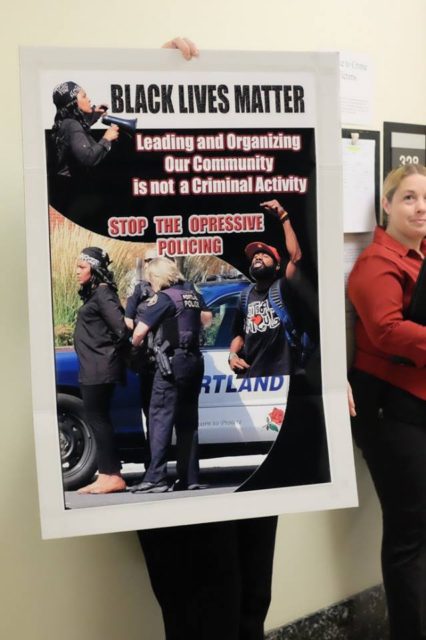
Photo by Kathryn Kendall
Then McHenry reminded the jury that the prosecution needed to show that Raiford’s objective was to stop traffic, something it had failed to do. Furthermore, he noted, none of the arresting officers were at the intersection during the occupation and, if the closing off of the intersection had created such a public inconvenience and annoyance, why were the prosecutors unable to bring to the stand “a single member of the public saying they were annoyed?”
“She was arrested because she’s Teressa Raiford,” McHenry intoned. “She was arrested because she speaks her mind and encourages others to do the same. She was arrested because she was standing up in the face of oppression and saying this is not okay…Let’s be real: she was arrested because she was targeted.” McHenry kept hammering on the various reasons the police–and ostensibly the State–would want to target Raiford and to “intimidate her into silencing her voice.”
The final nail in the coffin probably came when McHenry said the police lied about Raiford’s behavior and falsified their written reports. Lowe objected, but Judge Greenlick overruled him. From behind, I saw Lowe’s head jerk in surprise, and perhaps McHenry too was taken aback. It was almost as if Greenlick had–in the presence of the jury–agreed with McHenry.
Onward McHenry marched, noting how the prosecution did not want to talk about those falsified reports. They had portrayed Raiford as yelling, kicking, and in general being unhinged. “None of these things are true,” McHenry told the jury. And after Raiford’s turn on the stand, the jurors had no reason to believe otherwise.
Perhaps the last chance the prosecution had–if only to save face–was to argue that Raiford clearly could not have been targeted because another woman, Diane Chavez, was also arrested that day. McHenry chopped that down as well, noting that Chavez was told by police to get off the street at least seven times before they arrested her. Raiford, however, had at most been given only one warning.
Finally, McHenry noted, the state had sent in not one, but two prosecutors to obtain a conviction for a misdemeanor. This, he implied, was no different than how the police acted toward Raiford. The District Attorney’s office, like the police who showed up at the intersection of 82nd and Division, was targeting her.
Lowe gave a rebuttal, but he had nowhere to turn. He did the prosecutor’s version of throwing himself at the mercy of the court, reminding the jury that we were a society of rules, and that all rule breakers must be punished. He sounded meek, shallow, and petty. Within the context of a trial that featured much testimony about the Black Lives Matter movement as a response to police who clearly were not subject to those same rules, Lowe came across as someone blind to the reality in the backyard he was theoretically charged with helping oversee.
And when Lowe closed by stating, “I’m asking for justice,” I’m not entirely sure that anybody in the room understood what he could possibly be talking about. Instead, what Raiford and McHenry had shown was that the police and the District Attorney’s office, through Lowe and McMahon, had sought to bring their power to bear on Raiford to intimidate her and other members of the Black Lives Matter movement.
In retrospect, the verdict was simply a formality.
As Raiford stood in the hallway outside the courtroom, Aimee Green of the Oregonian asked if the jury had sent a message. Raiford said it had, and that was to “stop targeting Black people in Multnomah County. Stop it. End racial violence and excessive force. Stop profiling.”
The police, as well as the District Attorney’s office, may have bigger problems on their plates than changing their behavior. Billard’s testimony was exposed as a pack of lies, and those falsified written reports McHenry mentioned in his closing statement will surely arouse curiosity. In fact, while a contingent of Raiford’s friends and supporters waited in Lownsdale Park awaiting the jury to return its verdict, one of them said she had received a Twitter message saying quite a few attorneys were interested in reexamining cases in which Billard had provided testimony, as well as expressing wonder that the District Attorney would use testimony that was so easily shown to be so rife with prevarication.
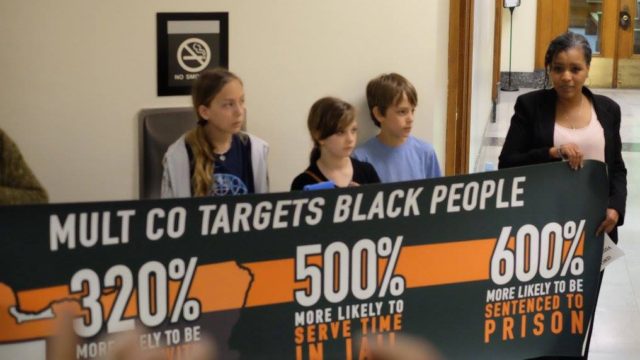
Photo by Kathryn Kendall
After the closing arguments had been completed and the jury had gone off to make its decision, I got to talk with Joe Meyer of KBOO who had been covering the trial. He is an optimistic sort, and he gave 10-1 odds that Raiford would be acquitted. I had similar feelings, but I did not want to express them: while it seemed so obvious Lowe and McMahon had not come close to proving their case, history is rife with examples where the jury renders the opposite of what seems obvious. In particular, there is no shortage of those occurrences when the trial involves people of color.
All victories are huge victories, even if they do not seem so at the time. The “official” huge victories–the ones that get splashed across the pages of the New York Times or make the history textbooks–do not come out of the ether. They are built upon numerous seemingly small victories–and defeats of all sizes as well.
Make no mistake: Raiford’s acquittal was a huge victory with deep roots. We are very fortunate in this city to have so many people like Raiford, including–but hardly limited to–Dr. Reverend Leroy Haynes of the Albina Ministerial Alliance; JoAnn Hardesty of the NAACP; educator and artist Walidah Imarisha; and Adrienne Cabouet, jamallah bourdon, and Ahjamu Umi of the All-African People’s Revolutionary Party who have spent so much time an effort in the pursuit of justice. We are also fortunate to have lawyers like McHenry, as well as Bronson James, the attorney who originally took her case, who in that same pursuit have provided their services for free. They and so many others have spent so much time bringing together so many together to educate, organize, and fight for a more just world–not just for people of color, but for all people.
Five years ago, I doubt Meyer would have given those odds, and I probably would not have dared to consider any form of optimism. Perhaps Billard’s testimony would have been accepted. Maybe the jury would have disregarded what was clear–that Raiford was targeted–and given the benefit of the doubt to the police because they knew them to be dedicated upholders of law and order. And perhaps the jurists would have never considered that the District Attorney would also be involved in targeting Raiford, and by extension, others involved in the Black Lives Matter movement.
Frederick Douglass famously said, “Power concedes nothing without a demand. It never did, and it never will.” When I got outside after Raiford’s acquittal on Thursday afternoon, the sun was shining bright, so much so that I had to apply sunscreen despite it still being April. It was a gorgeous day. People were soaking it up in Lownsdale and taking in the unseasonable warmth and light. They were wearing shorts as if it was late June. You couldn’t have painted a more perfect day.
However, when Raiford left the courthouse she headed up the sidewalk, away from the parks, in the cool shadows of the buildings. There were more demands to be made.







1 comment for “Teressa Raiford Acquittal A Major Victory on the Road to Reclaiming Justice in Face of Police Violence”